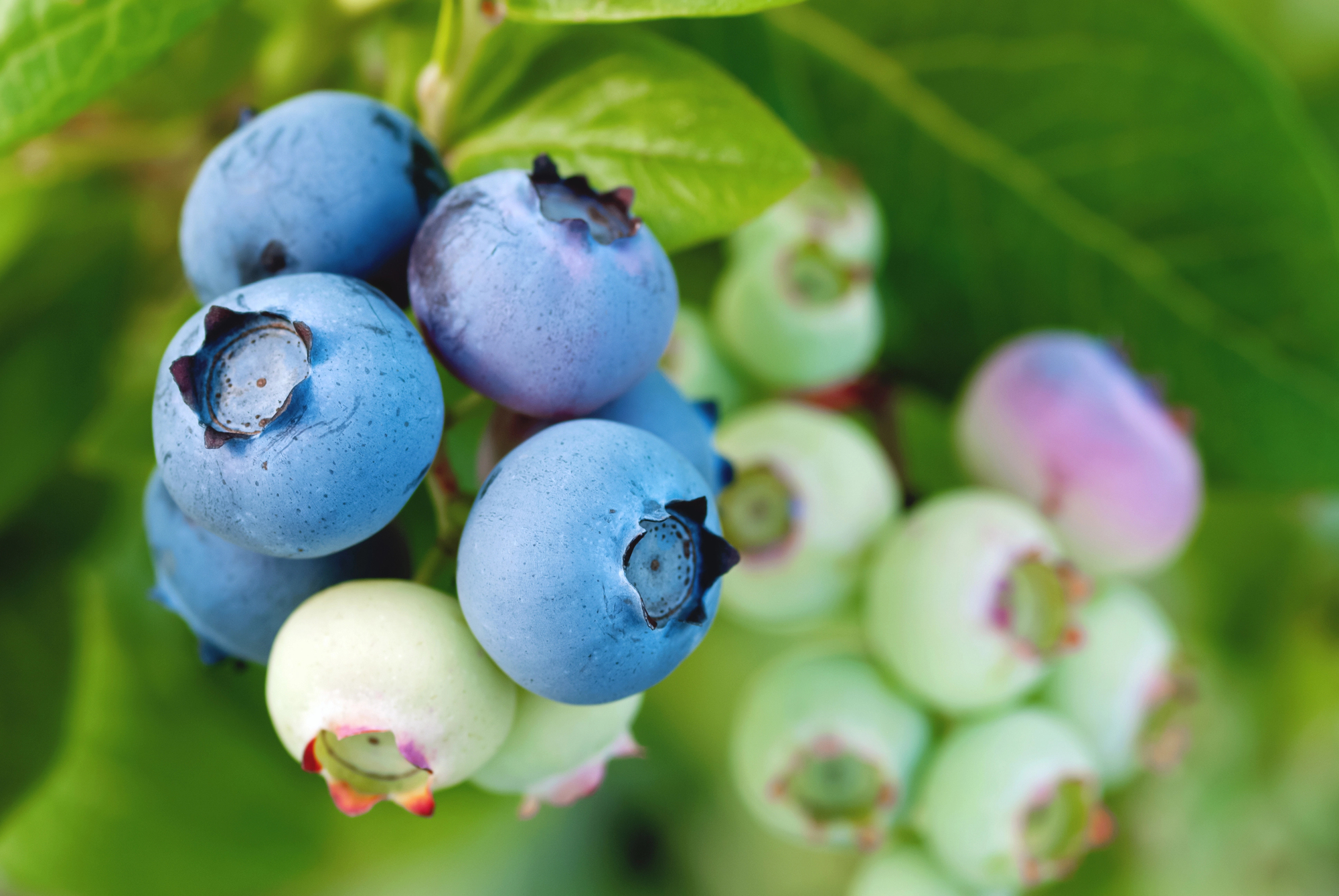Berry Donation Tracker
Quick Links: How & Where to Grow | Temperature | How to Care For | Harvest Signs | Harvesting | Pruning | Pests | Companions | Varieties | Preservation | Recipes | Michigan Tips | Fun Facts
🌱 How & Where to Grow Blueberries:
- Critical: pH 4.5-5.5 required – test soil BEFORE planting!
- Plant 2-3 year old bushes in early spring or fall.
- Space plants 4-6 feet apart in rows 8-10 feet apart.
- Plant 2+ varieties for cross-pollination and extended harvest.
- Sunlight: Full sun (6-8 hours) for best fruiting, tolerates partial shade.
- Soil Type: Well-drained, acidic soil rich in organic matter.
- Soil Amendment: Add sulfur to lower pH, peat moss for acidity and organic matter.
Michigan’s naturally acidic soils are often perfect – but always test first!
🌡️ Temperature Guidance:
Need 400-1,000 chill hours. Hardy to -20°F. Flowers damaged at 28°F.
- Winter chill: Different varieties need different hours below 45°F.
- Spring frost: Open flowers killed at 28°F – choose late-blooming varieties.
- Growing season: Optimal fruit development at 60-80°F.
- Dormancy: Fully dormant plants extremely cold hardy.
- Michigan easily meets chill requirements for all varieties!
Late spring frosts are the biggest threat – site selection is crucial!
💧 How to Care for:
- Consistent Moisture: 1-2 inches weekly – critical during fruiting.
- Watering: Use drip irrigation or soaker hoses – avoid overhead watering.
- Mulch: 4-6 inches of pine needles, sawdust, or wood chips.
- Fertilizer: Use acid-loving plant fertilizer, avoid nitrate forms.
- pH monitoring: Test annually – maintaining proper pH is crucial!
📏 Harvest Signs:
Deep blue with bloom. Easy release. Wait 5-7 days after turning blue.
- Color: Completely blue with whitish “bloom” on berries.
- Firmness: Slight give when gently squeezed.
- Release: Ripe berries fall into hand with gentle touch.
- Patience pays: Berries continue sweetening after turning blue!
- Not all berries ripen at once – expect 3-6 harvests per season.
The longer berries stay on the bush after turning blue, the sweeter they become!
🧺 Harvesting:
Harvest every 5-7 days. Gently roll berries off cluster. Keep cool immediately.
- Use both hands: One to hold cluster, one to gently roll off ripe berries.
- Morning harvest: After dew dries but before heat of day.
- Don’t pull: Ripe berries release easily – force means not ready.
- Container choice: Shallow containers prevent crushing.
- Cool quickly: Get berries into shade/refrigeration ASAP.
✂️ Pruning:
No pruning first 3 years. Annual dormant pruning after. Remove 1/3 old wood.
- Years 1-3: Remove flowers only – let bush establish.
- Mature bushes: Prune in late winter before bud break.
- Remove: Dead, damaged, crossing, and low branches.
- Renewal: Cut 1-2 oldest canes to ground annually.
- Open center: Improve air circulation and sun penetration.
🪲 Michigan Pests:
Birds (netting essential), Japanese beetles, blueberry maggot, mummy berry.
- Birds: #1 pest – use netting when berries start turning blue.
- Japanese beetles: Skeletonize leaves – hand-pick or use traps away from bushes.
- Blueberry maggot: Tiny flies lay eggs in fruit – use yellow sticky traps.
- Spotted wing drosophila: New pest – harvest promptly when ripe.
- Mummy berry: Fungal disease – remove affected berries, mulch well.
🫱🏽🫲🏼 Companions:
Good with thyme, azaleas. Other acid-lovers share soil needs.
- Acid-loving plants: Azaleas, rhododendrons, camellias thrive together.
- Thyme: Ground cover that doesn’t compete for nutrients.
- Avoid: Plants needing alkaline soil or heavy feeders.
- Cover crops: Clover between rows fixes nitrogen.
- Pine trees: Natural companions – needles help acidify soil.
🫐 Varieties:
‘Patriot’, ‘Duke’, ‘Bluecrop’, ‘Jersey’, ‘Elliott’.
- ‘Patriot’: Early, cold hardy, large berries, good for fresh eating.
- ‘Duke’: Early, consistent producer, excellent flavor.
- ‘Bluecrop’: Mid-season, most popular variety, reliable.
- ‘Jersey’: Late, small berries excellent for baking.
- ‘Elliott’: Very late, extends season into September.
🫙 Preservation:
Freeze unwashed on trays. Can as jam/preserves. Dehydrate. Fresh 1-2 weeks.
- Freezing: Don’t wash – spread on trays, freeze, then bag.
- Fresh storage: Refrigerate unwashed in covered container 10-14 days.
- Canning: Make jam, jelly, or pie filling – follow tested recipes.
- Dehydrating: Makes sweet “blueberry raisins.”
- Wine/juice: Excess berries make excellent beverages.
🧑🏽🍳 Recipes:
Blueberry pie, muffins, pancakes, jam, fresh eating, smoothies.
- Michigan blueberry pie – the state’s signature dessert!
- Blueberry lemon muffins for breakfast.
- Fresh blueberry sauce for pancakes and ice cream.
- Blueberry BBQ sauce for grilled meats.
- Simple syrup for cocktails and lemonades.
✋🏼 Michigan Tips:
- Michigan is the #1 highbush blueberry producer in the U.S.!
- West Michigan’s sandy soils naturally acidic – perfect for blueberries.
- SE Michigan clay needs major amending – consider raised beds.
- Plant on north slopes to delay spring bloom, avoiding frost.
- Michigan-bred varieties often best adapted to our climate.
- Join Michigan Blueberry Growers Association for local tips.
🧠 Fun Facts:
- Native to North America – one of few fruits originating here!
- Michigan produces 100+ million pounds annually.
- Blueberries are one of the highest antioxidant foods.
- Native Americans called them “star berries” – see the star on top?
- A single bush can produce for 50+ years with proper care.
- The Vaccinium genus includes cranberries and lingonberries too.
- July is National Blueberry Month.
- One cup contains only 84 calories but 24% daily vitamin C!


0 Comments